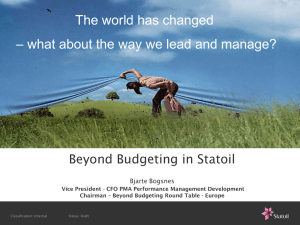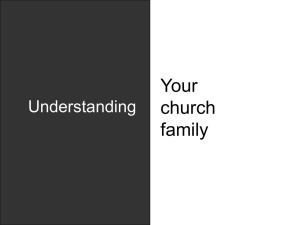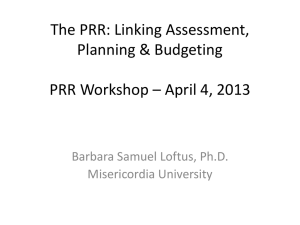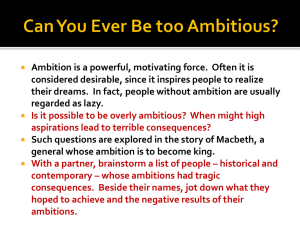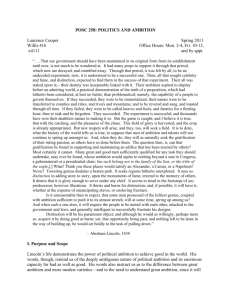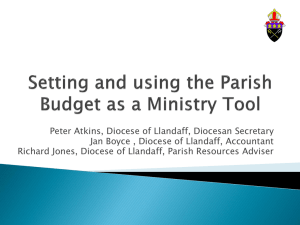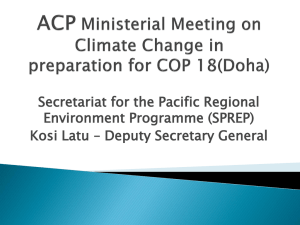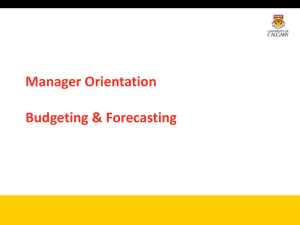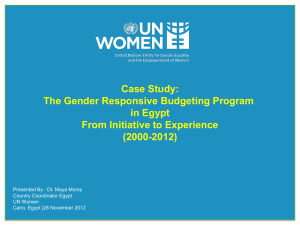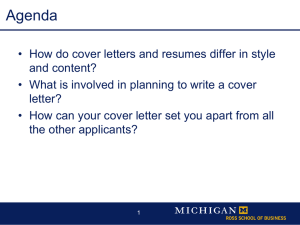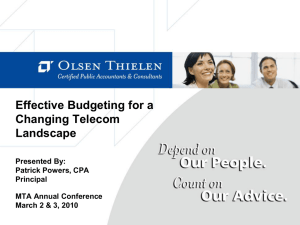Budget - Gurus of BI
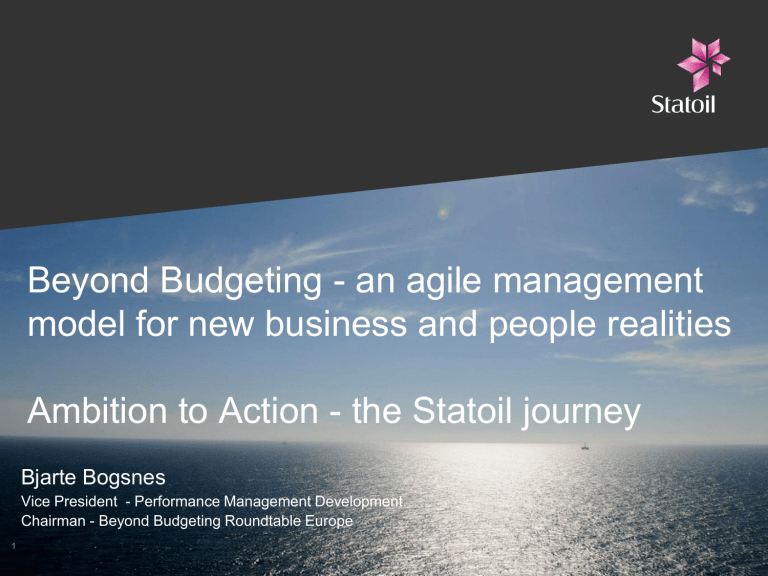
Beyond Budgeting - an agile management model for new business and people realities
Ambition to Action - the Statoil journey
1
Bjarte Bogsnes
Vice President - Performance Management Development
Chairman - Beyond Budgeting Roundtable Europe
2
Outline
• The case for change - what is the problem?
• The Beyond Budgeting principles
• The Statoil model - Ambition to action
3
Statoil in brief
• Turnover approx. 130 bn. USD
• 23000 employees in 33 countries
• World’s largest operator in waters deeper than 100 metres
• Second largest gas exporter to
Europe
• World leader of crude oil sales
• Listed in New York and Oslo
US Gulf of Mexico
North Sea & Norwegian Sea
Canada
North Africa
South America
West Africa
Arctic
Russia
Caspian
Middle East
East Africa
Aus/Indo.
Current production of oil and gas
4
Fortune 500 ranking (2011)
Social responsibility Innovation
5 -
Some of the budget problems
Often weak link to strategy
Very time consuming
Decisions made too early and often too high up
Assumptions quickly outdated
Can prevent value adding activities
“Accordion” forecasting horizon
Often a bad yardstick for evaluating performance
Irritating itches - or symptoms of a bigger problem?
6
Managing traffic performance - one alternative
Who is in control?
Based on which information?
7
Managing traffic performance
- another alternative
Who is in control?
Based on which information?
Which is most efficient ?
Which is most difficult ?
8
In which are values most important?
9
The world has changed what about the way we lead and manage?
Business environment
Traditional management
”Theory X” ”Theory Y”
People
10
We must change both processes and leadership
Processes
No traditional budgeting
Relative and directional goals
Dynamic planning, forecasting and resource allocation
Holistic performance evaluation
Rigid, detailed and annual
Rules-based micromanagement
Centralised command and control
Secrecy, sticks and carrots
”Theory X”
Beyond Budgeting
Values based
Autonomy
Transparency
Internal motivation
”Theory Y”
Leadership
11
11
Companies on a similar journey
12
The Beyond Budgeting principles
Change in leadership
1. Values - Govern through a few clear values, goals and boundaries, not detailed rules and budgets
2. Performance - Create a high performance climate based on relative success, not on meeting fixed targets
3. Transparency - Promote open information for self management, don ’t restrict it hierarchically
4. Organization - Organize as a network of lean, accountable teams, not around centralized functions
5. Autonomy Give teams the freedom and capability to act; don
’t micro-manage them
6. Customers - Focus everyone on improving customer outcomes, not on hierarchical relationships
Change in processes
7. Goals - Set relative goals for continuous improvement, don ’t negotiate fixed performance contracts
8. Rewards - Reward shared success based on relative performance, not on meeting fixed targets
9. Planning - Make planning a continuous and inclusive process, not a top-down annual event
10. Coordination - Coordinate interactions dynamically, not through annual planning cycles
11. Resources - Make resources available as needed, not through annual budget allocations
12. Controls - Base controls on relative indicators and trends, not on variances against plan
13
Start of the Statoil journey
- solving a serious budget conflict
The budget purposes
Step 1
Separate
Step 2
Improve
Budget =
•Target
•Forecast
•Resource allocation
“Same number – conflicting purposes
”
Target
What we want to happen
Forecast
What we think will happen
Resource allocation
”Different numbers”
• Inspiring & motivating
• Relative where possible
• Holistic performance evaluation
• Unbiased - expected outcome
• Limited detail
• Dynamic - no annual allocation
• KPI targets, mandates, decision gates & decision criteria
• Trend monitoring
“Event driven
- not calendar driven ”
14
Financial performance - as we define it
Total Shareholder Return 2012 Return on Capital (
RoACE
) 2012
15
The mindset required…..
– cost conscious from the first penny
Do I have a budget for this?
Is this really necessary?
What is good enough?
How much value is this creating?
Is this within my execution framework?
Budget
Not
OK
OK
OK?
OK?
OK?
OK?
OK?
16
…..and the tools available
Traditional cost budget
Detailed and annual
Absolute KPIs
Ambition level / burn rate
Unit cost input/output
Relative KPIs
Unit cost vs peers
Bottom line focus only
If no KPIs found
Strategic objectives or actions only
Xx
Xx
Xx
Xx
Xx
Xx
Xx
Xx
1003,4 ~1000
”USD/bbl”
”USD/customer”
”USD/employee”
”1. quartile”
”Better than average”
EBIT
RoACE
(abs/rel)
” A simplified and cost conscious way of working”
“More video - less travel ”
Increasing autonomy and flexibility
Increasing need for strong values and clear direction
Select based on what works best in your business
Monitoring of actual development, intervention if needed only
17
Ambition to Action - purpose and process
• Translating strategy - from ambitions to actions
• Securing flexibility - room to act and perform
• Activating values and leadership principles
Strategic objectives
KPIs
Actions & forecasts
Where are we going – what does success look like?
• Most important strategic change areas
• Medium term horizon
How do we measure progress?
• Indicative measure of strategic delivery
• 5-10 KPIs, shorter/ longer term targets
How do we get there?
• Concrete actions and expected outcome
(forecast)
• Clear deadlines and accountabilities
Individual or team goals
What is my or our contribution?
My Performance Goals
• Delivery
• Behaviour
18
Ambition to Action example
People &
Organisation
HSE
Where are we going?
”Strategic objectives ”
Operations
Market
Finance
How do we measure progress?
”Key
Performance
Indicators ”
How do we get there?
”Actions”
19
More than 1400 ”Ambition to Action’s” across the company
…..and more
20
A broader performance language
- from narrow measurement to a holistic assessment
Ambition to Action r y v e
D e i l
50/50 B e h a v i o u r Pressure testing KPI results:
• Deliver towards the strategic objectives?
• How ambitious KPI targets?
• Changed assumptions, with positive or negative effect?
• Agreed actions implemented, or corrective actions initiated as needed?
• Delivered results sustainable?
Living the values
• Day-to day-observations
• 360 ° / 180 ° / 90 ° surveys
• People survey
• Development plan
• Rewards
Towards a simpler, more dynamic and selfregulating Ambition to Action process
More cost conscious
less «cost cutting»
More event driven
- less calendar driven
More translation
- less cascading
More relative
- less absolute KPIs
More transparency
- less secrecy
Simple is not the same as easy!
22
Questions or comments - now or later?
Bjarte Bogsnes bjbo@statoil.com
+ 47 916 13 843
Twitter @bbogsnes
Beyond Budgeting Round Table www.bbrt.org
23
Want to hear more?
1.
The problems with traditional management
2.
The Beyond Budgeting model
3.
The Borealis case
4.
The Statoil case
5.
Implementation advice
Out on Wiley (US)
Available from e.g. Amazon.co.uk
(Now available in Russian and Japanese)
24 -
Back-up
25
Beyond Budgeting
why it’s different, difficult and powerful
Granularity
Many leadership theories
Complexity theory
Lean, Agile, Holocracy
Beyond
Budgeting
Balanced Scorecard
Budgeting
TQM, ABC etc…
Elements only
Management agenda
The whole Coverage
26
The CEO on Ambition to Action
27
Delivery goals are based on Ambition to action - directly or indirectly
Ambition to action
Directly
Indirectly
”Manager”
Translated goals
”Team member” without own Ambition to action
Translated goals
”Other employees”
Why a holistic performance evaluation?
28
Fixed targets struggle in a dynamic world
Create comfort around ambitious targets
KPIs are indicators, does not always tell the full story
”
Not everything that counts can be counted, and not everything that can be counted counts
(Albert Einstein)
Always wiser in hindsight, always more information
29
Implementation advice
• Create problem understanding before talking solutions
• What’s the real risk – upside vs downside
• Design to 80% and jump
• A ”pull-based” approach
• ”One war but a thousand battles”
• Involve HR
• Don’t become a fundamentalist
